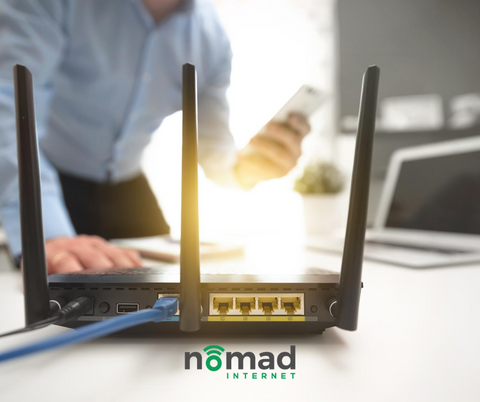
Nomad Internet is committed to providing top-quality equipment for stronger Wi-Fi signals. Our routers are powered by the latest technology that connects to any of your devices and propagates the signals to evenly cover your house.
However, you may find yourself in a situation where you cannot connect to Wi-Fi from some parts of your home. That mainly happens based on the way the router is positioned. Luckily, there are a couple of ways you can move your equipment and evenly spread out the signals.
Read on to learn how best to position your router for stronger Wi-Fi signals.
1. Centrally place your router
Routers are built in such a manner that they transmit signals in all directions. The signals are similar to sound waves which equally travel to the front, back, and sides. That implies if you were to place your router at the center of your home, there would be a high chance of most corners being covered. A router that is placed close to the window means most of your broadband is broadcasted to the outside. You will be literally throwing out some of the strongest connections.
A centrally placed router is also a security mechanism in disguise. When it is in the middle, it means most of the signals are made to revolve within your home. Even if some signals may be out there, they will not be that strong. If outsiders cannot detect your Wi-Fi, chances of them compromising your connection are minimized.
2. Keep off walls
Walls act as signal barriers by absorbing them and compromising the quality of your broadband. Their thickness makes it pretty difficult for Wi-Fi to pass through. When positioning your equipment, try as much as possible to keep away from walls.
It is advisable to keep your Nomad Internet equipment close to open doorways. Doing so grants the signals unobstructed passage.
3. Keep off electronic items
Do not place your router close to electronic items like the TV, baby monitors, cordless phones, and home music system. These devices emit radio signals that interact with the Wi-Fi signals, causing reduced quality.
4. Do not install it in the kitchen.
In a fast-paced world where something new is ever happening every second, most of us do not want to be left out on anything, even while in the kitchen. As such, you may be tempted to install the router here, especially if most of your time is spent here.
The kitchen has other equipment that emits much stronger signals than those emitted by your router. For instance, microwaves release stronger electromagnetic waves of 2.4 GHz compared to the weaker 2.4 GHz emitted by routers. Even though the microwaves are well-covered, there may be occasional leakages that make your Wi-Fi unusable.
Besides the physics discussed above, it is generally a risk to install routers in the kitchen. Accidental spillages could easily destroy the entire equipment.
5. Tweak around the antennae
Not all routers come with an antenna. The purpose of these antennae is to help propagate signals. If your router has one, tweaking them around may have a mild impact on how far the signals are received.
Generally, if you have your router upstairs, you can help spread the signals between the two floors by stretching the antennas sideways. If it is in the lower part, point the antennas upwards.
You may get top-quality Internet into your router, but how this gets from the equipment to your device is determined by its positioning. Rather than just plugging your router at any joint, consider the factors discussed above for stronger Wi-Fi signals. Nomad Internet is committed to delivering the best quality service.
Share on Social Media!
